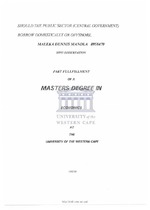| dc.description.abstract | 1. Taxes are an important source of government revenue (income). A failure by the
government to collect sufficient taxes to cover for its ever increasing
expenditures, engenders fiscal problems. Amongst others the government is
compelled to borrow to finance its budget short fall. In this instance, should the
government borrow domestically or offshore to finance its short fall .
2. Amongst the theories discussed in this paper, are the views of the Neoclassical
Keynesian and the Ricardi an schools of thought. Further more, South African
theories on government debt are also discussed.
3. There is a considerably large number of indicators that can be used to determine
an appropriate level of both domestic and foreign debt of a country. Certain well
establish criteria such as the ratio of foreign interest payments to exports, the ratio
of foreign debt to gross domestic product, the ratio of·govemment debt to gross
domestic product and the ratio of foreign debt to exports, are amongst the pool of
indicators that can be used. However, the following indicators have been
identified as the most commonly used in the analysis of budget deficits, and they
are; ratio of deficit before borrowing and debt repayment to GDP, the ratio of
government debt to GDP, the ratio of interest payments to government
expenditure, the level of real interest rates relative to economic growth and the
net asset value or net worth of the government.
4. Deficit financing refer to the ways in which the budgetary gap is financed.
Overreliance on domestic borrowing may mean high real interest rates and falling
investment, and overreliance on foreign borrowing can cause appreciating real
exchange rates and unsustainable external indebtedness, amongst others.
5. Amongst the available remedies for debt ills in this country, is the suggestion to
significantly cut government expenditure. However, realities currently
confronting the authorities, like the increase in public servants as a result of the abolishment of homelands and the constitutionally guaranteed employment of
civil servants from the old order, automatically put pressure on public
consumption.
6. On the international front, South Africa is underborrowed. In this regard favour
should go more for offshore borrowing. Certainly South Africa has to generate the
means of meeting debt obligations by running a surplus of exports over imports of
goods and services. The bulk of the country's debt is of domestic origin which
account for well over 90 % of total debt. The current anti inflationary monetary
policy with its concomitant high interest rates, makes domestic borrowing more
costly. | en_US |

